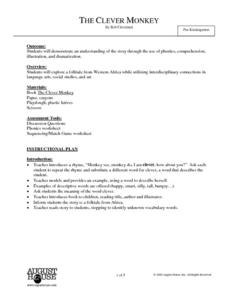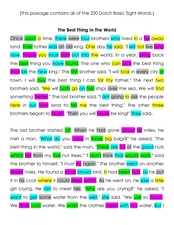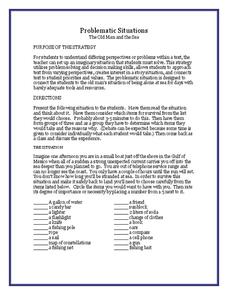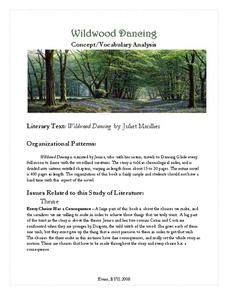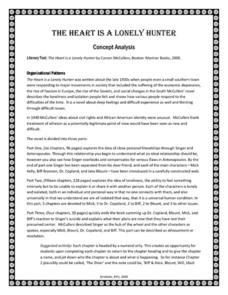Pearson
Main Idea
The main idea of this resource is that you should take a look if you're planning to teach main ideas in your class! Cover just about everything you need to know about main ideas with a packet of materials that includes information and...
Prestwick House
Speak
Speaking your mind and standing up for yourself is the message of Laurie Halse Anderson's novel Speak. Readers review key details about characters, setting, and plot points with a crossword puzzle all about Speak.
EngageNY
Forming a Research-Based Claim: Cascading Consequences Chart
Can you put that in writing? Scholars work with a partner to write a practice claim before writing their own claims. After writing their claims, learners share with class using a Concentric Circles activity.
August House
The Clever Monkey
Your clever kindergartners will enjoy a series of activities based on the West African folktale, The Clever Monkey, adapted by Rob Cleveland. They sequence the story with pictures, copy sentences, illustrate idioms about cats,...
Houghton Mifflin Harcourt
American Stories: Extra Support Lessons (Theme 2)
Here's a packet designed especially for those kids who need extra support with the basic concepts in the Houghton Mifflin Harcourt thematic units on American stories.
Houghton Mifflin Harcourt
Journeys: Extra Support Lessons (Theme 1)
Kids who need extra support mastering the concepts in the Houghton Mifflin Harcourt thematic units on journeys, will benefit from the exercises and activities contained in this 40-page resource packet.
E Reading Worksheets
Fact and Opinion - Worksheet: 5
After reading 25 sentences, individuals decide if they are facts or opinions. Then, they explain their answer in a supporting sentence.
E Reading Worksheets
Fact and Opinion - Worksheet: 3
How can you prove a fact? With supporting evidence, of course. Learners read 25 statements and determine if it is fact or opinion. Then, if the statement is a fact, youngsters write a sentence explaining how they can prove it.
E Reading Worksheets
Fact and Opinion - Worksheet: 4
Instruct pupils to determine if a statement is a fact or an opinion with a language arts worksheet. After reading the sentence and circling the answer, learners explain how they know their answer is correct.
E Reading Worksheets
Fact and Opinion - Worksheet: 2
After reading a statement, learners decide if it is a fact or opinion. Then, they write a sentence explaining how they know their answer is correct. The sheet contains 25 fact and opinion sentences.
Read Works
Fireflies
A short story about a nighttime adventure at summer camp provides readers with a chance to practice their comprehension skills.
Teach-nology
Means the Same
Reinforce grammar instruction with an 11-question synonym worksheet. Scholars read a set of four words and circle the two that best make a synonym pair.
Teach-nology
The Purpose of Summaries
How can you tell the author's purpose from just a short summary? Kids read three different summaries of books to determine whether the author meant to entertain, persuade, or inform.
Curated OER
Dolch Words in a Story
After studying all of the 220 Dolch basic sight words, your class can read this great short story that includes every word. You can have your readers circle each sight word as they go.
Curated OER
Test Your Reading Skills-- Any Answers 3
In this language arts worksheet, students practice answering a question with a logical clear response. Students read 10 questions and choose the most appropriate answer.
EngageNY
Text to Film Comparison: Bottom’s Transformation
Scholars meet in a drama circle to discuss what they remember from reading A Midsummer Night's Dream Act III, Scene 1 in the last activity. They then take turns reading the scene aloud, stopping to answer questions as they read. Learners...
EngageNY
Analyzing a Model Position Paper: “Changing Our Water Ways”
Follow the leader for better writing! Scholars analyze a model position paper, "Changing Our Water Ways." During the first pass, they listen as the teacher reads the paper aloud. They then do a second read of the paper and complete a...
Curated OER
The Old Man and the Sea: Problematic Situations
Bring the drama of Ernest Hemingway's The Old Man and the Sea to class with a fun role-playing activity. Given a list of survival items, readers decide which items would be the most necessary for an adventure like...
EngageNY
Author’s Craft: Poetry and Prose
During a drama circle, scholars closely examine the play created in the play A Midsummer Night's Dream. The pupils read Act 3 Scene 1 and turn and talk to their partners about the scene. They then complete a handout and discuss the...
EngageNY
Characters’ Decisions: The Flow of Consequences in Midsummer
Class members meet in their drama circles and share their thoughts on why it might be necessary for the audience to know something the characters don't. They read Act 3 Scene 2 of A Midsummer Night's Dream and complete consequence flow...
EngageNY
Launching A Midsummer Night’s Dream: Identifying the Characters, Settings, and Conflicts
Scholars form a drama circle and begin reading Shakespeare's A Midsummer Night's Dream. They also use a play map to identify the setting, characters, and conflicts from the text.
EngageNY
Launching The Performance Task: Building Background Knowledge: “War in the Pacific,” Part 1
It's all about a bit of give and take. Scholars silently read War in the Pacific and circle any unfamiliar words. Using context clues, they write each word on a strip of paper along with the inferred definition. After looking the word up...
Novelinks
Wildwood Dancing: Concept/Vocabulary Analysis
Considering including Juliet Marillier's young adult novel, Wildwood Dancing as part of your language arts curriculum? Check out an overview that examines some of the themes and issues presented by the novel.
Novelinks
The Heart Is a Lonely Hunter: Concept Analysis
Considering Carson McCullers' The Heart Is a Lonely Hunter for whole-class reading or as a selection for book circles? Check out this resource that overviews the organizational patterns, themes, plot structure, tone, and setting.





